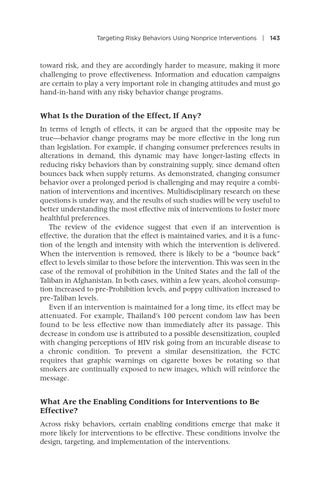Targeting Risky Behaviors Using Nonprice Interventions | 143
toward risk, and they are accordingly harder to measure, making it more challenging to prove effectiveness. Information and education campaigns are certain to play a very important role in changing attitudes and must go hand-in-hand with any risky behavior change programs.
What Is the Duration of the Effect, If Any? In terms of length of effects, it can be argued that the opposite may be true—behavior change programs may be more effective in the long run than legislation. For example, if changing consumer preferences results in alterations in demand, this dynamic may have longer-lasting effects in reducing risky behaviors than by constraining supply, since demand often bounces back when supply returns. As demonstrated, changing consumer behavior over a prolonged period is challenging and may require a combination of interventions and incentives. Multidisciplinary research on these questions is under way, and the results of such studies will be very useful to better understanding the most effective mix of interventions to foster more healthful preferences. The review of the evidence suggest that even if an intervention is effective, the duration that the effect is maintained varies, and it is a function of the length and intensity with which the intervention is delivered. When the intervention is removed, there is likely to be a “bounce back” effect to levels similar to those before the intervention. This was seen in the case of the removal of prohibition in the United States and the fall of the Taliban in Afghanistan. In both cases, within a few years, alcohol consumption increased to pre-Prohibition levels, and poppy cultivation increased to pre-Taliban levels. Even if an intervention is maintained for a long time, its effect may be attenuated. For example, Thailand’s 100 percent condom law has been found to be less effective now than immediately after its passage. This decrease in condom use is attributed to a possible desensitization, coupled with changing perceptions of HIV risk going from an incurable disease to a chronic condition. To prevent a similar desensitization, the FCTC requires that graphic warnings on cigarette boxes be rotating so that smokers are continually exposed to new images, which will reinforce the message.
What Are the Enabling Conditions for Interventions to Be Effective? Across risky behaviors, certain enabling conditions emerge that make it more likely for interventions to be effective. These conditions involve the design, targeting, and implementation of the interventions.
